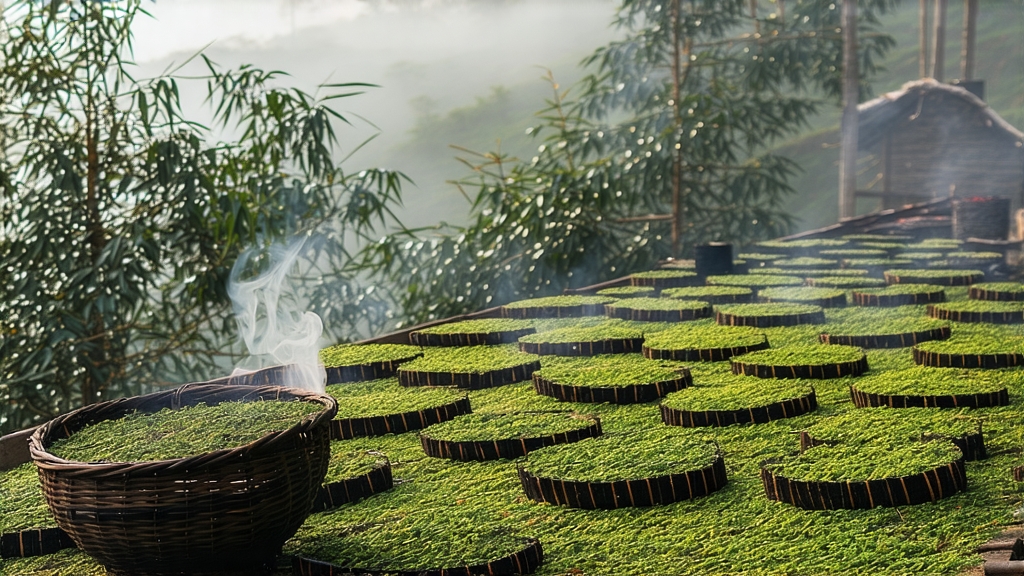
When European tea drinkers first encountered the dark, twisted leaves that produced a liquor the color of claret, they did not yet have the word “black tea.” Instead they called the shipment from the port of Xiamen “bohea,” a corruption of the Minnan phrase wuyi, naming the granite massif where the story of black tea begins. Centuries later, that original bohea is still grown on the same sheer cliffs, still withered over smouldering pine, and still carries the name Lapsang Souchong—literally “small leaf from the original mountain.” To understand Chinese red (hong) tea, one must start here, in the nature reserve of Tongmu Guan, where the myth of smoke, pine, and time is retold with every cup.
History: From Mountain Refuge to Global Passion
The Tang dynasty left records of compressed white teas pressed for the northern horse trade, but the first documented fully oxidized leaf appears in the late Ming, around 1604, when fleeing soldiers disrupted the normal green-tea routine in Wuyi. To save the harvest, farmers hastily dried the leaves over open pine fires; the accidental smoke found eager buyers among the Dutch, who re-exported it to London, Paris, and St. Petersburg. By the 1660s, Catherine of Braganza had made Lapsang Souchong the fashionable drink of the English court, and the British East India Company was paying for it with Mexican silver. The tea’s success spurred industrial espionage—Robert Fortune’s 1848 theft of tea plants and craftsmen—and thus every Indian, Sri Lankan, and Kenyan black tea traces its lineage back to these misty Wuyi canyons.
Terroir: Why Tongmu Guan Cannot Be Cloned
UNESCO lists the 60-kilometre core zone of Wuyishan as a biosphere reserve; pesticides are banned and entry is by permit only. At 600–1,200 m, the gorge traps humid monsoon clouds that condense into perpetual fog, shading the tea bushes and forcing slow growth. The soil is weathered volcanic tuff, so porous that rainfall disappears within minutes, obliging roots to dive three metres for mineral water. Indigenous pine species (Pinus massoniana) carpet the slopes; their resinous heartwood provides the smoking fuel that defines the tea. Attempts to replicate the process in flatland factories—even using identical cultivars—fail to reproduce the sweet, cooling aftertaste locals call “rock rhyme,” proof that terroir is more than geography; it is an ecological symphony.
Cultivars: Three Bushes Worth Knowing
- Xiao Zhong Qi Zhong (“original small species”): seed-grown bushes over 150 years old, tiny leaves, intense pine fragrance, limited to 300 kg per year.
- Wuyi Caicha (“vegetable tea”), a landrace selected by monks in the Song dynasty, gives a softer, orchid note when smoked lightly.
- Jin Jun Mei’s mother bush: a late-sprouting wild variant discovered in 2005, whose downy buds are now processed unsmoked into the honeyed Jin Jun Mei, but when traditionally smoked becomes “Jin Lapsang,” a connoisseur’s secret.
Craft: The Eight Stages of Smoke and Fire
Plucking begins at Qingming, when two leaves and a bud are still 70 % the size of a fingernail. The leaves are laid into bamboo trays set upon elevated racks inside the smokehouse. A gentle pine fire (28–30 °C) raises leaf temperature just enough to wilt cells without “cooking” them; this is called “softening.” Rolling follows, done by hand on rattan mats: the farmer’s palms press and twist for 45 minutes until cell sap coats the leaf surface like morning dew. Oxidation is carried out in cedar-lined wooden boxes; the pile is turned every 20 minutes so that every leaf breathes the same humid oxygen, turning from jade to copper. Now comes the signature step—pinewood smoking. Freshly split Masson pine is stacked into a pit; the fire is damped so it barely glows, producing resinous smoke that rises through mesh screens holding the tea. Temperature must stay below 75 °C; higher and the leaves will char, killing the coveted longan-sweet finish. This cycle—smoke, rest, smoke—repeats for up to eight hours. Finally the tea